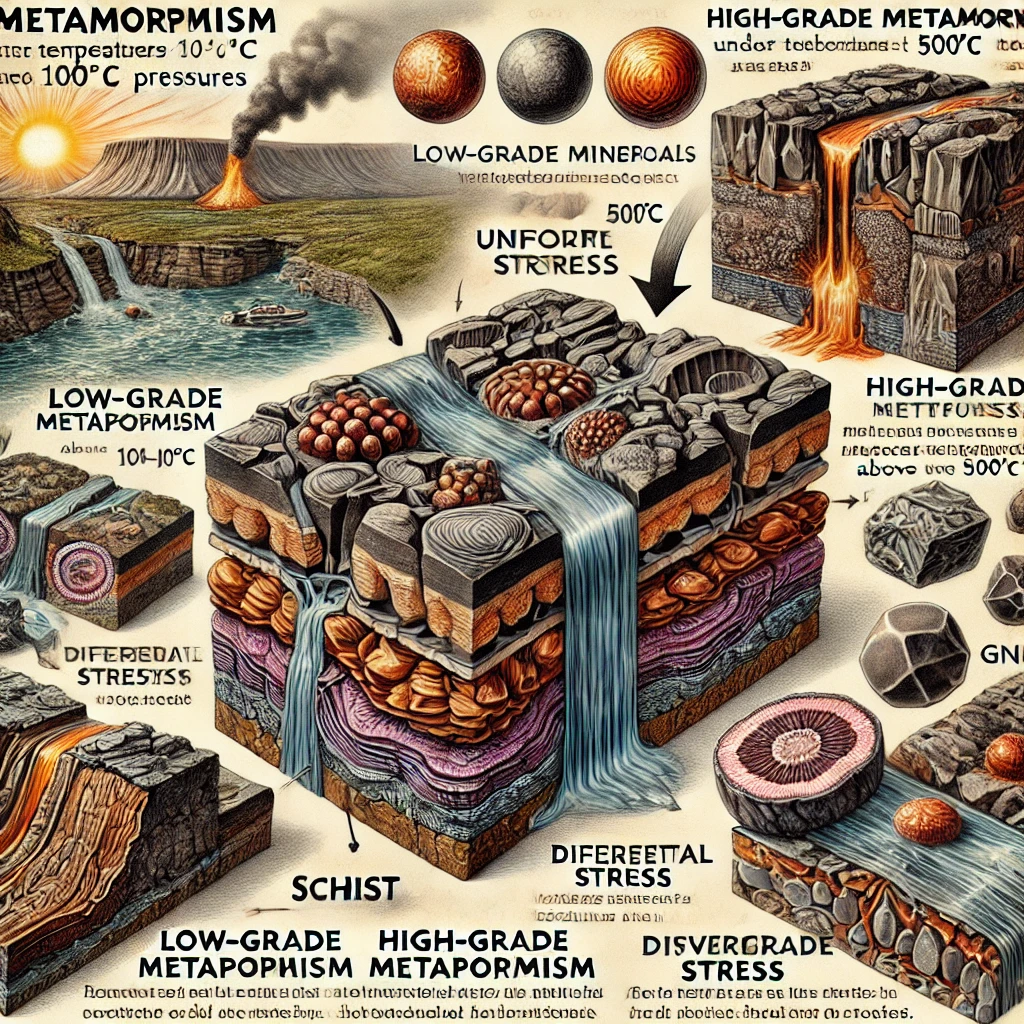Explains metamorphism, the transformation of rocks into new mineral combinations and textures by changes in temperature and pressure inside the Earth, and covers the formation process and geologic significance of metamorphic rocks.
Earth is a dynamic planet that is constantly changing, with a variety of geologic processes constantly taking place within its interior. One of these processes is metamorphism. Metamorphism is the process by which changes in temperature and pressure alter the mineral composition and organization of rocks in the Earth’s crust. It occurs at a variety of depths and conditions, from the Earth’s deepest to shallow crust, and takes different forms and results in different geologic settings.
In general, metamorphism that occurs at temperatures of about 100 to 500 °C and relatively low pressures is called hypogeogenic metamorphism, and metamorphism that occurs at high temperatures and relatively high pressures of about 500 °C or more is called hypergeneous metamorphism. These two types of metamorphism reflect the complex thermal and mechanical environment inside the Earth, and each produces different metamorphic rocks under different conditions.
Among the many factors that influence metamorphism, one of the most important is temperature. When you mix flour, salt, sugar, yeast, and water and put it in an oven, the high temperature triggers a series of chemical reactions to create a new compound: bread. Similarly, when a rock is heated, some of the minerals in it recrystallize and others react with each other to create new minerals, with the end product being metamorphic rock. The heat applied to rocks usually comes from the Earth’s interior. Much of this heat is supplied when rocks are moved into the Earth’s interior by tectonic movements such as subduction* or continental collision. The temperature of the Earth’s interior increases at different rates depending on the internal environment of the crust, but generally increases the deeper you go into the Earth’s interior. This increase in temperature makes metamorphism more active. For example, when shale, a sedimentary rock containing clay minerals, is buried inside the Earth, the high temperature inside the Earth causes the minerals inside the rock to merge with each other or create new minerals, resulting in metamorphic rocks: low metamorphic rocks become slate, and high metamorphic rocks become schist or gneiss.

In addition to temperature, pressure also plays an important role in metamorphism. Pressure is another important factor that causes rocks to metamorphose. Pressure with a constant force in all directions is called ‘uniform stress’, while pressure with a greater force in one direction is called ‘differential stress’. Metamorphic rocks are mainly produced under differential stress conditions, resulting in the development of distinctly oriented textures. As metamorphism progresses, minerals such as mica and biotite begin to grow, with the layers oriented perpendicular to the direction of maximum stress. The faceted organization of these newly formed plate-like mica minerals is called foliation. Rocks that show foliation tend to break apart into thin plates. And when foliation is observed, it is an important indication of metamorphism. Low-metamorphic rocks are composed of very fine grains, so the newly formed mineral grains can be observed using a microscope, and the foliation is called ‘spotting’. On the other hand, when highly metamorphosed, the grains become larger and individual mineral grains can be observed with the naked eye. This is called ‘convenient’ foliation.
When a solid undergoes a change, it tends to preserve the effects of the change, unlike a liquid or gas. Because metamorphic rocks are changed from a solid state, they preserve a record of everything that happened in the Earth’s crust. Interpreting the records they preserve is a huge task for geologists. This allows us to gain a deeper understanding of Earth’s history and the processes of crustal change. For example, by studying metamorphic rocks, we can shed light on Earth’s early history and estimate the direction of crustal movement and pressure conditions. The fossils and sedimentary structures contained in metamorphic rocks provide important clues for reconstructing ancient environments, which can also help us study climate change today.
The study of metamorphic rocks also plays an important role in resource exploration and environmental science. By understanding how metamorphic rocks form and change, it is possible to determine the distribution and formation conditions of mineral resources, which contributes to the efficiency of resource exploration. For example, in areas where certain metamorphic rocks are present, there is a high probability that useful mineral resources associated with them are present, making the study of metamorphic rocks essential for exploration and development. The study of metamorphic rocks also helps in the prediction and prevention of geological disasters. Geologic disasters, such as earthquakes and volcanic eruptions, can be predicted through the structure and properties of metamorphic rocks, and ways can be found to prepare for them in advance.
Metamorphism is more than just a change in rocks; it is closely related to the dynamic internal workings of the Earth. As such, the study of metamorphic rocks has important academic implications not only for geology, but for the earth sciences as a whole. Metamorphic rocks allow geologists to explore the Earth’s past and make predictions about future global changes. Understanding how metamorphic rocks form and change is at the core of the earth sciences, giving us the key to unlocking the Earth’s remarkable history. The study of metamorphic rocks provides important clues to understanding Earth’s complex internal structure and dynamics, allowing us to more accurately predict and prepare for the planet’s future.
